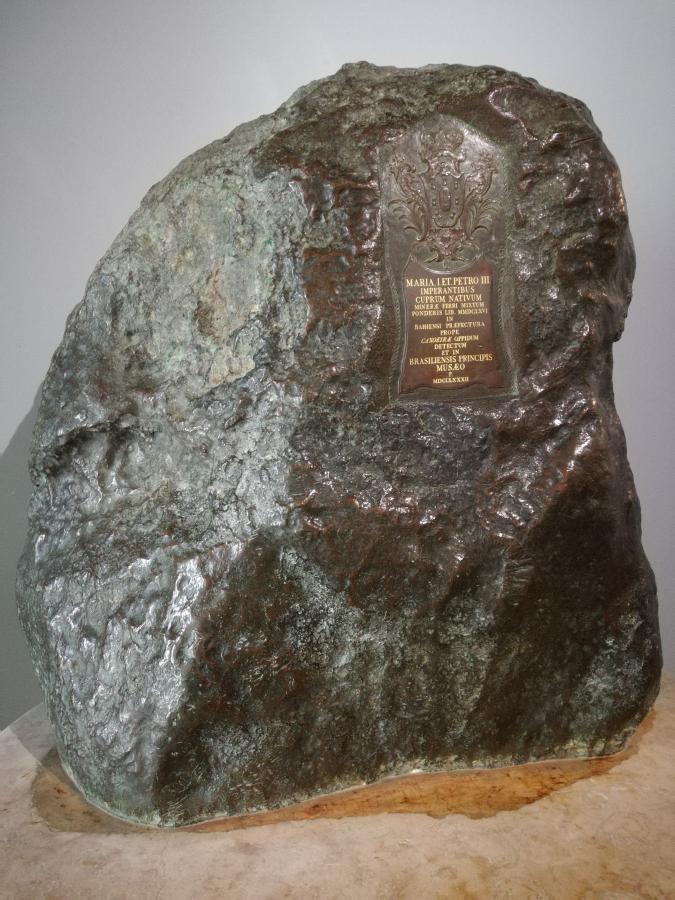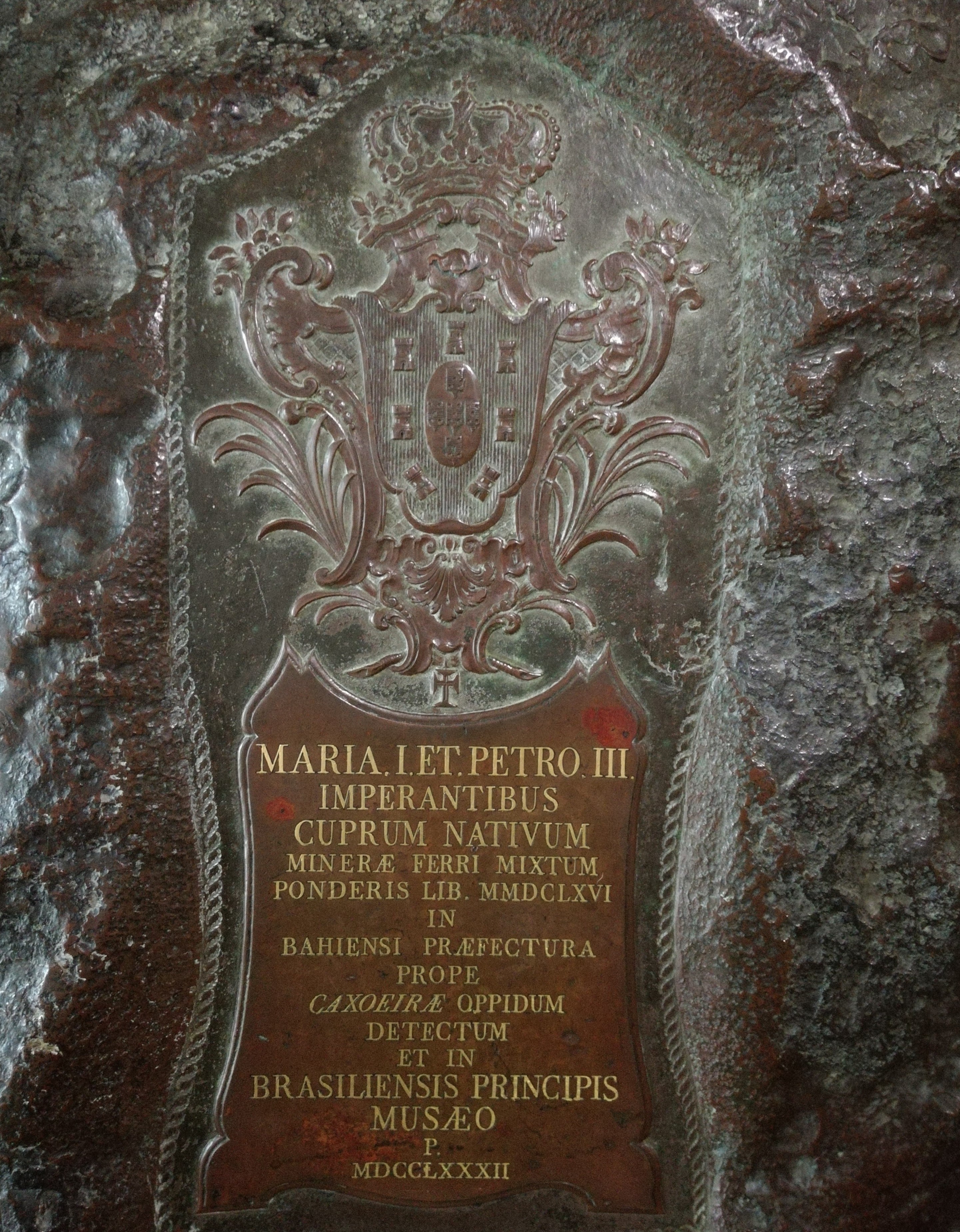
Objeto do mês
O Bloco de Cobre Nativo é um exemplar que integra as Coleções Geológicas do Museu Nacional de História Natural e da Ciência, mas é também um objeto com forte simbolismo histórico que nos remete para as origens do Museu.
O Bloco (com cerca de 90 cm de altura máxima por cerca de 62 cm de largura na base e 25cm de espessura) está encastrado numa peanha de mármore, ao estilo do séc. XVIII, e ostenta uma inscrição em latim, gravada na própria massa de cobre e encimada pelo escudo real utilizado, então, pela monarquia portuguesa. A leitura do texto em latim ou na sua tradução para o português atual, que acompanha o exemplar, informa o visitante que:
 | No reinado
|
Do estudo das indicações deixadas por esta inscrição ficamos a saber várias coisas.
Assim, “Museu do Príncipe” era uma designação corrente do “Real Museu de História Natural e Jardim Botânico da Ajuda” que, em 1768, havia sido criado junto do Palácio da Ajuda para instrução dos príncipes. Os autores da inscrição quiseram, certamente, enfatizar a relação da coroa com o Brasil através da designação “Príncipe do Brasil” que era um dos títulos dos príncipes herdeiros ao trono de Portugal. Na altura tratava-se de D José que, por ter falecido jovem, não chegou a reinar tendo-lhe sucedido D. João VI, que foi Príncipe do Brasil e, mais tarde, Rei de Portugal e Imperador do Brasil.
Este “Real Museu” cedo se revelou um centro de investigação significativo para a época, que reunia apreciáveis coleções de história natural, ao mesmo tempo que passava a abrir à população um dia por semana, sendo bastante concorrido. Cabe-nos referir que “Real Museu de História Natural e Jardim Botânico da Ajuda” foi a primeira designação e localização daquele que, depois de instalado no edifício da Escola Politécnica, nos séculos XIX e XX se passou a designar Museu Nacional de História Natural e, atualmente, Museu Nacional de História Natural e da Ciência, onde se encontra exposto o objeto em referência.
O naturalista Domingos Vandelli, criador e primeiro diretor (entre 1768 e 1810) do “Real Museu”, realizou um estudo do Bloco e a análise química do seu material constituinte, tendo verificado que era composto por 97% de cobre e que não havia vestígios de ouro ou prata. O estudo de Vandelli foi publicado num extrato de “Varias observações de Chimica e Historia Natural”, In: Memórias da Academia Real das Sciencias de Lisboa, Tomo I, de 1780 a 1788, Lisboa 1797, p. 261. Análises recentes confirmaram que os 3% restantes correspondem a ferro.
Quanto ao peso do Bloco de Cobre, convertendo libras em quilogramas, atinge-se o valor de 1209 kg.
Falta aludir ao significado da designação “nativo” atribuída a este exemplar de cobre. De facto, na natureza, apenas pouco mais de trinta elementos químicos se conhecem existindo livres ou como ligas. Na sistemática dos minerais estes agrupam-se na classe designada “Elementos Nativos” à qual pertencem, entre outros, o ouro, a prata, o diamante, a grafite, e também o cobre. A designação “nativo” atribuída a esta massa de cobre pretende significar que ela é natural e não resulta de algum procedimento humano.
******
O recebimento de esta tão grande massa de cobre fez despertar o interesse em saber se proviria de alguma jazida com dimensão e interesse para ser minerada. Curiosamente o Bloco de Cobre chegou ao Museu de História Natural um ano antes do início das designadas “Viagens Philosophicas” que tiveram início em 1783. Estas viagens constituíram, porventura, o mais significativo empreendimento científico e museológico dessa época e foram destinadas à inventariação e descrição dos territórios e dos recursos naturais das, então, colónias. Elas foram preparadas, incluindo a formação dos 4 naturalistas enviados a outros tantos territórios, primeiro na Universidade de Coimbra e, finalmente, no Real Museu, na Ajuda.
Coube ao enviado aos territórios de Moçambique e da Índia, Manuel Galvão da Silva, o encargo de, na viagem de ida, fazer escala na Baía e ir verificar, na cidade de Cachoeira, o significado e a dimensão daquela ocorrência. Com as entidades locais deslocou-se a Mamocabo, lugar próximo da cidade de Cachoeira onde o bloco de cobre fora encontrado.
Situava-se numa aluvião de rio. Segundo carta enviada por Galvão da Silva para o “Real Museu” em Lisboa, toda a zona foi calcorreada apesar da chuva e do mau tempo que se fazia sentir, mas nada mais foi assinalado. Apenas se conhecia, proveniente daquela localização, um outro fragmento de cobre mas de muito menor dimensão.
No entanto sabemos que existem várias minas de cobre no Estado da Baía e que, em textos descritivos daquela região cerca de 1587, é referida a existência “de uma serra muito grande que não tem outra cousa senão cobre, que está descoberto sobre a terra em pedaços feitos em concavidades, (….) parece senão que já foi fundido” (Tratado Descriptivo do Brasil em 1587, por Gabriel Soares de Sousa, 1938, pp 428 e 429)
Será o bloco uma pepita que em circunstâncias excecionais pôde atingir uma dimensão gigantesca? Ou terá sido uma massa de cobre transportada e caída no decurso de um atravessamento do rio?
Certo era o desejo do Brasil (expresso em carta enviada para Lisboa em 1799 pelo Intendente de Minas, Manuel Ferreira da Câmara) de chamar a atenção da coroa para a importância de explorar outras riquezas que não só a cana-de-açúcar.
NATIVE COPPER BLOCK
The Native Copper Block is part of the Geological Collections of the National Museum of Natural History and Science, but it is also an object with a strong historical symbolism that takes us back to the origins of the Museum.
The Block (about 90 cm high at the top, 62 cm wide at the base and 25 cm thick) is set in a marble pedestal in the 18th century style and bears a Latin inscription engraved in the copper mass itself and topped by the royal coat of arms used at the time by the Portuguese monarchy. Reading the Latin text or its translation into current Portuguese, which acc Reading the text in Latin or in its current Portuguese translation, which accompanies the specimen, informs the visitor that:
 | During the reign
|
From studying the indications left by this inscription, we learn several things
The "Prince's Museum" was a common name for the "Royal Museum of Natural History and Botanical Garden of Ajuda" which, in 1768, had been created next to the Ajuda Palace for the instruction of the princes. The authors of the inscription certainly wanted to emphasise the crown's relationship with Brazil through the designation "Prince of Brazil", which was one of the titles of the princes heir to the throne of Portugal. At the time, it was D José who, having died young, did not get to reign and was succeeded by D João VI, who was Prince of Brazil and, later, King of Portugal and Emperor of Brazil.
This "Royal Museum" soon proved to be a significant research centre for the time, bringing together significant natural history collections, while it was also open to the public one day a week and was very popular. It should be noted that "Real Museu de História Natural e Jardim Botânico da Ajuda" was the first name and location of what, after being installed in the Polytechnic School building, in the 19th and 20th centuries was renamed the National Museum of Natural History and, today, the National Museum of Natural History and Science, where the object in question can be found.
The naturalist Domingos Vandelli, creator and first director (between 1768 and 1810) of the "Real Museu", carried out a study of the Block and a chemical analysis of its constituent material, finding that it was composed of 97% copper and that there were no traces of gold or silver. Vandelli's study was published in an extract from "Varias observações de Chimica e Historia Natural", in: Memórias da Academia Real das Sciencias de Lisboa, Tomo I, de 1780 a 1788, Lisboa 1797, p. 261. Recent analyses have confirmed that the remaining 3% corresponds to iron.
As for the weight of the Copper Block, converting pounds into kilograms produces the value 1209 kg.
The meaning of the designation "native" attributed to this copper specimen remains to be seen. In fact, in nature, only 34 chemical elements are known exist free. In the systematics of minerals, these are grouped in the class known as "Native Elements", to which gold, silver, diamond, graphite and copper belong, among others. The designation "native" given to this mass of copper is intended to signify that it is natural and not the result of some human procedure.
*****
The receipt of such a large mass of copper sparked an interest in whether it came from a deposit large enough to be mined.
Curiously, the copper block arrived at the Natural History Museum a year before the start of the so-called "Philosophical Journeys", which began in 1783. These voyages were perhaps the most significant scientific and museological endeavour of the time and were designed to inventory and describe the territories and natural resources of the then colonies. They were prepared, including the training of the four naturalists sent to also four colonial territories, first at the University of Coimbra and finally at the Royal Museum in Ajuda.
Manuel Galvão da Silva, who was sent to Mozambique and India, was given the task of making a stopover in Baía on the outward journey and checking out the significance and scale of the event in the city of Cachoeira. With the local authorities, he travelled to Mamocabo, the place near the city of Cachoeira where the copper block had been found.
It was located on a river alluvial fan. According to a letter sent by Galvão da Silva to the "Royal Museum" in Lisbon, the whole area was searched despite the rain and bad weather, but nothing else was found. Only one other copper fragment was known to have come from that location, but it was much smaller.
However, we know that there are several copper mines in the state of Baía and that, in texts describing the region from around 1587, the existence of "a very large mountain range that has nothing but copper, which is discovered on the ground in pieces made into concavities, (.....) it seems but that it has already been smelted" is mentioned (Descriptive Treaty of Brazil in 1587, by Gabriel Soares de Sousa, 1938, pp 428 and 429)
Was the block a nugget that, under exceptional circumstances, was able to reach a gigantic size? Or was it a mass of copper transported and dropped during a river crossing?
Certain was the desire on the part of Brazil (expressed in a letter sent to Lisbon in 1799 by the Mining Intendant, Manuel Ferreira da Câmara) to draw the crown's attention to the importance of exploiting riches other than sugar cane.
PROGRAMA ALARGADO
21 dezembro
15h00 - Visita orientada à exposição "Minerais: Identificar, Classificar"
Venha conhecer o Objeto do Mês e a exposição de minerais do Museu, numa visita orientada pela curadora Liliana Póvoas.
Inscrições
geral@museus.ulisboa.pt | 213 921 808